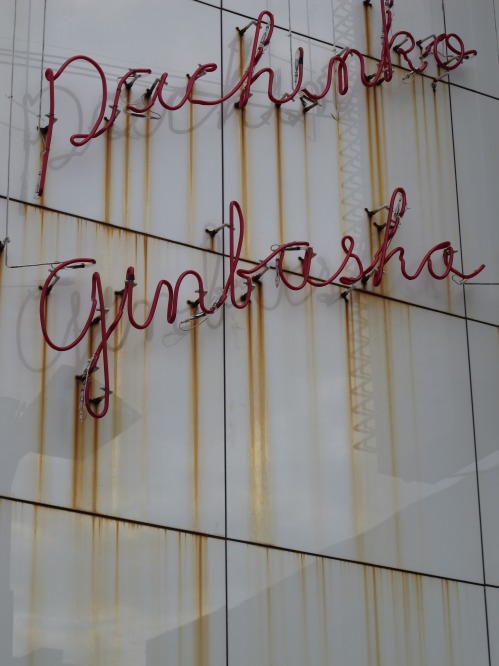
A dismal, depressing subject can be made enjoyable by great writing. And the spirits can be lifted by an awesome photo at the end. These are my takeaways from Richard Hendy’s travel/history/economics/politics/apocalyptic decline essay on Amakusa, a hardscrabble group of islands near Kyushu, Japan.
Hendy’s blog Spike Japan documents the underside and overlooked, and Amakusa certainly sounds like it’s had the short end of the stick since forever, basically, and all they have to show for it is a 15-year-old, $120 million Bridge To Nowhere–designed by Renzo Piano.
But this incredible photo gives me hope. I’m transfixed by this pachinko sign. I mean, just look at those lines. The neonya-san who made that is literally drawing with light in space here. Is there a kanji-based, gestural tradition within the Japanese neon signmaking industry? Have Zen brushstrokes been translated or reperformed and fixed in 3D glass tubing? Or maybe it’s Action Painting, frozen in time and space instead of dropped onto the canvas in the barn in Springs?
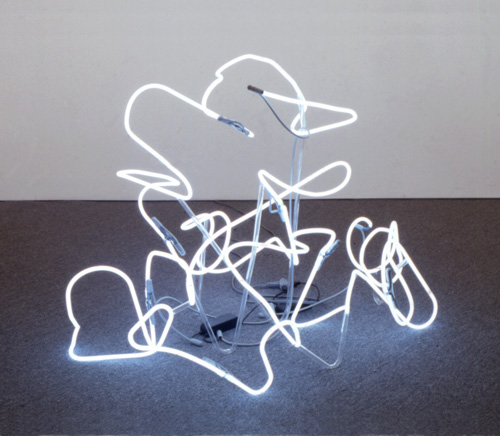
Perhaps Peter Coffin’s 2004 sculpture, Untitled (Line after B. Nauman’s The True Artist Helps the World by Revealing Mystic Truths) 1, isn’t abstract at all, but documentary. Perhaps the topic could be addressed by a panel discussion at a future symposium, after Amakusa’s calligraphic lighting sector has been revitalized, and the island has claimed its rightful place as the Japanese Marfa for the neon arts.
1 which, hello, is now in MoMA’s collection.
At The Movies With Mao Zedong
Tom Scocca posted about the story just before Christmas, but apparently, Mao Zedong was a Bruce Lee fan.
That’s how the Chinese press is reporting the story of Liu Qingtang, [刘庆棠], a ballet dancer and close ally of Mao’s wife Jiang Qing, who, as the deputy minister, was put in charge of films at the Ministry of Culture.
Mao was encouraged because of cataracts to cut down on his reading, and to switch to film. Liu was charged with programming and procuring prints for Mao’s private screenings.
Scocca picked the story up from Raymond Zhou in China Daily, but Liu’s account was first published in November in the Yangcheng Evening News, a major daily out of Guangzhou. It was posted online a few weeks later. Here’s the Chinese, “毛泽东有多迷李小龙?”, and a choppy Google translation, “Mao Was a Bruce Lee Fan?” [It’s remarkable how far Chinese-English autotranslation still has to go. We’re barely at Babelfish levels here.]
Liu says his story is from 1974:
Mao Zedong’s like to watch movies there are several categories: first, the international award-winning film; second film biography, “Abraham Lincoln”, “Napoleon,” he loves; third is like watching garden scenery film, like most British films. Often, Mao heard good movie, the file will be down to watch, watch movies right away, very happy.
. At some point, then, Liu traveled to Guangzhou, and on to Hong Kong, where he had not a little bit of trouble getting prints of Lee’s films, The Big Boss, Fist of Fury and The Way of the Dragon, from the wary movie mogul Sir Run Run Shaw.
Where Mao would watch only a few minutes at a time, taking up to ten days to finish another film, he apparently sat straight through Lee’s movies, and even demanded repeat viewings. Liu was afraid to send the prints back to HK, in case Mao asked to see them again.
The incorporation of Mao into the Bruce Lee fan club, the American-born, Hong Kong-raised, one-quarter German Lee [who is known by his given Cantonese name, Li Jun-fan (李振藩)] was timed with the premiere on CCTV6 of a documentary, “Legend of Bruce Lee,” which debuted at Beijing University. It all serves to retroactively position Lee as an inspiring, nationalistic hero of all Chinese, including the Mainland, where he was unknown during his lifetime.
And it all makes me wonder what was actually going on film-wise in the PRC during the tumultuous waning days of Mao’s rule. Because there are some contradictions and gaps in Liu’s story as it’s reported:
Wikipedia, which has the only actual date I can find so far, says Liu was installed as Deputy Culture Minister in February 1976.
Jonathan Clements’ 2006 biography of Mao dates the cataracts to 1974, but also says that Mao was nearly blind, and his slurred speech could only be decoded by his nurse.
As Reeve Wong pointed out to China Daily, Bruce Lee’s films were actually produced by Shaw’s rival studio, Golden Harvest. It’s not clear how or where, but Liu still insists that he got the prints from Shaw.
Given the difficulty in tracking down prints of Hong Kong’s most popular films, I have to wonder what “international award-winning films” and biopics Liu was able to get his hands on. I mean, was there a copy of John Ford’s 1939 film Young Mister Lincoln laying around a cinema after the Revolution?
And the big question, did he watch Michelangelo Antonioni’s epic 1972 documentary Chung Kuo? Antonioni originally shot Chung Kuo/ Cina as a left-to-left cultural gift, with Communist Party participation and supervision. After it came out, though, Madame Mao & her cinematic comrades denounced spectacularly as a capitalist reactionary insult to the Motherland.
A lengthy bio of Liu Qingtang at hudong.com says that in 1976 as the Gang of Four maneuvered for post-Mao power, Minister Liu personally oversaw the production of three “hit films,” Back [反击]、Grand Festival, [盛大的节日], and Fight [搏斗] which attacked Deng Xiaopeng.
After Deng regained and consolidated power and began undoing the effects of the Cultural Revolution, Liu followed the Gang of Four into public disgrace, trial and jail. But he’s apparently out now, and doing fine, if not quite keeping his dates and titles straight.
Toward A Cyclorama-Shaped Gettysburg Memorial To The Wounded

See, this is what I’m talking about. And by see, I mean look. Last Spring, while trying to save Richard Neutra’s Gettysburg Cyclorama building from destruction by the Park Service and misguided preservationists, I backed into the idea of adapting it as a wheelchair-accessible battlefield observation platform. [Observation platforms are the primary category of structure the Park Service exempts from its professed objective to “restore” the battlefield to its 1865 condition.]
A perfect complement to a disabled/wheelchair-accessible structure would be a memorial or exhibit for those soldiers wounded in battle. While honoring those who sacrifice so much for their country, such a tribute would also bring the issues of the disabled and the disfigured out from the shadows where they have been relegated for centuries, educating all visitors as to the truer human cost of war.
Fortunately, such an exhibit and the educational value it can provide have long been contemplated by folks like Mike Rhode and his colleagues in the archives of the National Museum of Health and Medicine, which boingboing points out began during the Civil War as the Army Medical Museum. Rhode posted a photoset of documentary photos, artifacts, and period documentation of Civil War casualties and medical treatments. The almost industrial scale of battlefield injuries and the largely forgotten threat of disease and infection spurred on major advances in treatment, surgery, amputation, prosthetics, and sterilization.
So check out Rhode’s flickr for a difficult-to-see example of what an important-to-see exhibit might look like.
And consider that if Neutra’s Gettysburg building were to hold such a memorial, it would begin to pay back some of the karma deficit modernist drum-shaped architecture incurred when the Army Medical Museum was torn down to make way for the Hirshhorn Museum.
Related, next, a year later, in fact: Gettysburg and the Disney/Ken Burns Effect
Deck The Halls With Satelloons

Via David at BoingBoing comes slow word that the world’s largest airship hangar is now a Malaysian conglomerate-owned water park. So says the Smithsonian’s Air & Space magazine.
The structure was built in 2000 on a repurposed military base south of Berlin in the former East Germany by Carl von Gablenz’ industrial airship startup, CargoLifter AG. It is 360 meters long, 210 meters wide, and 107 meters high, more than large enough to accommodate the firm’s proof-of-concept vehicle, the CL75 Air Crane.
The CL75 was built and tested in 2001. The 60-meter diameter spherical balloon was 60 meters in diameter. Also, it was 60 meters in diameter. That’s almost 200 feet, people. It’s almost as if someone heard about Project Echo’s 100-foot satelloon, and decided to double it [apologies to all the 7th graders in the audience, who know that doubling the diameter of a sphere more than doubles the volume. The point here is the pure optics of the number.]

But why a gratuitous reference to Project Echo, one wonders? Oh, maybe because the CL75’s airship was manufactured by TCOM, the former Westinghouse subsidiary which began in 1960 as an attempt to commercialize British WWII barrage balloons for aerial surveillance. And which, since 1996, has been housed in the disused USN airship hangar in Weeksville, NC. [“The TCOM Manufacturing and Flight Test Facility near Elizabeth City, NC has become the East Coast hub for all airship activity.”]
Which is the same disused USN airship hangar the original Project Echo team used to test inflate their first satelloon. Just check out the vented windows in the giant clamshell doors:
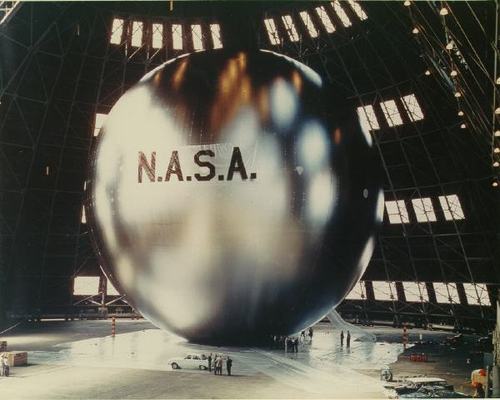
The CL75 was destroyed in a storm in 2002, the same year CargoLifter went bankrupt. But fortunately, the East Coast hub for all airship activity soldiers on.
‘Someone May Have Located The Stolen Painting’
It’s exactly the kind of scribbled note I dug through five boxes of Smithsonian archival material hoping to find: “Someone may have loc. stolen ptg. So Charles will talk to Bob about it.”
Well, I talked to Charles about it. The artist Charles Yoder worked for Robert Rauschenberg for five years, until around 1975-6. So I called him, and unfortunately, he had no idea where the Johns flag painting was, the one which had been removed from Short Circuit in the mid-60s [Michael Crichton says before 1965.] He did say there was “scuttlebutt,” at the time, a general awareness that there was a Johns flag painting on the loose. But it never went beyond the, “I heard some guy was trying to sell it on the Bowery,” type urban legendry.
But though I didn’t find any smoking guns, or burned flags, in the records from Walter Hopps’ 1976 Rauschenberg retrospective at the National Collection of Fine Arts, I did learn some more interesting details about Short Circuit and its complicated history.
Like, for one thing, the 1955 combine was not actually shown in Hopps’ retrospective.
Continue reading “‘Someone May Have Located The Stolen Painting’”
Browser Tab Cut Or Run
So much to blog, so little time. I may have to institute a new practice of dumping my interesting-looking browser tabs if I don’t write about or use them within a month, or blogging about them.
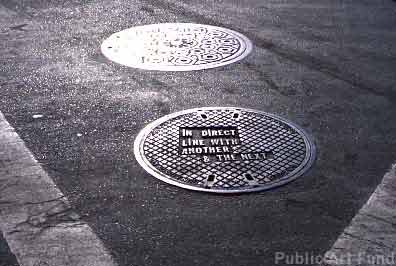
For example, ever since seeing a Le Corbusier manhole cover from Chandigarh sell for almost EUR18,000, I’ve been meaning to take this list of locations for Lawrence Weiner’s 2000 Public Art Fund project, and see which of his 19 downtown manhole covers looks the most lootable. But you know how it is with scheduling, holidays, pangs of conscience, snow, &c. &c…
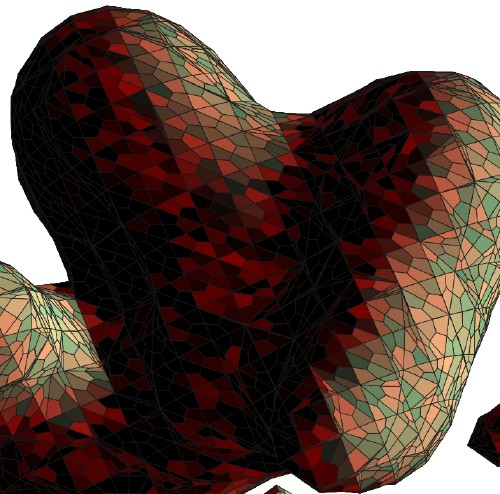
So via Zelkova’s long essay on interactivity and digitization, I find this intriguing 2003 project, C & C, from the Lyon design studio Trafik. Joel, Pierre, and Julien all responded [merci, fellas!] to explain that C & C began as an exploration for a method to create designs for a handmade carpet. So they created a program in C that used the 3D coordinates of shapes created in Autodesk 3ds Max [above] to generate a 2D vector graphic [below].

Needless to say, I like the translational aspects of the project almost as much as I do the Dutch camo landscape-like polys.
One nice consequence of my recent Short Circuit research is seeing and reading up on Sturtevant. From Bruce Hainley’s Aug 2000 essay in Frieze:
As Sturtevant puts it: ‘Warhol was very Warhol’.
This is a complicated statement. How did Warhol get to be ‘very Warhol’? How does one come to recognise – see, consider – a painting, film , or anything by Warhol once he and everything he’s done are slated only to be ‘a Warhol’? It is Sturtevant who knows how to make a Warhol, not Warhol. It is Sturtevant who allows a Warhol to be a Warhol, by repeating him. Copy, replica, mimesis, simulacra, fake, digital virtuality, clone – Sturtevant’s work has been for more than 40 years a meditation on these concepts by decidedly not being any of them.
I’m kind of disheartened by how interesting Chris Burden’s post-minimalist undergraduate work sounds in this fully illustrated repro of Robert Horvitz’s Artforum cover story from May 1976 [volny.cz]
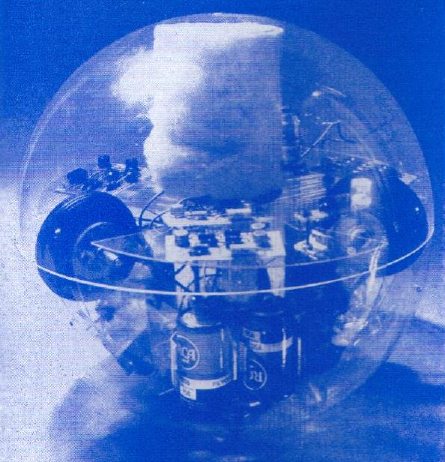
Via the awesome cyberneticzoo.com comes Toy-Pet Plexi-Ball a the 1968 artist/engineer colabo sculpture by Robin Parkinson and Eric Martin, which was included in Pontus Hulten’s MoMA show, “The Machine: As Seen at the End of the Mechanical Age.” The light-and-sound-activated Toy-Pet rolled around the gallery following viewers, until you put it in its fake fur bag. Which made it look like a tribble. Which can’t be a coincidence, can it, Pontus? If you have an engineer collaborating with an artist a year after the Star Trek episode airs?
Awesome kinetic/robotic artist James Seawright was one of the six artists–along with Aldo Tambellini, Thomas Tadlock, Allan Kaprow, Otto Piene, and Nam June Paik–who contributed to WGBH’s groundbreaking TV show/happening The Medium Is The Medium. Which is right in front of my face. And I’ve been staring at everyone but Seawright and Tadlock for a year. At this rate, I’ll be fawning over Tadlock sometime next summer.
Since my Google Street View Trike book project is entirely about the subject, I suspect I’ll keep Olivier Lugon‘s November 2000 Etudes Photographiques essay, “Le marcheur: Piétons et photographes au sein des avant-gardes,” open a little longer. Along with the Google translation.
Whither Washington, Post-Gopnik?
You know, some things have just been bugging me about this Blake Gopnik/Washington Post situation. I deeply don’t care about Gopnik in a gossipy way. I suppose if I were pressed, I’d be generically glad for him now that it has been reported that he’s going to work for Tina Brown in New York as a “special correspondent, arts,” even though the I could also imagine that gig could/would be utterly irrelevant, and the specifics of it could be excruciating. Fortunately, that’s not my problem.
I’m more interested in what his departure says about art-related writing and criticism in Washington, DC. In other words, what does it reveal about state of the Washington Post, does it have any implication for Gopnik’s replacement?
Because, this:
It hasn’t been two weeks since Tyler Green wrote that Gopnik “has been doing the best work of his career on the Smithsonian fiasco.”
I’d say that’s a bit of a low bar, but I have to agree; Gopnik came out quickly, clearly, and strongly in defense of art, Wojnarowicz, and curatorial independence. And before that, he’d already given the National Portrait Gallery’s “Hide/Seek” an excellent and strong review.
Fine.
But here’s the thing: we know now that when he wrote this “best work,” he was either interviewing, auditioning, or negotiating for his new gig.
Badass LEGO Instruction Manuals, Vol. 2
Did I mention that I got a copy of the 316-pg instruction manual for Lego Set 10179-1: The Ultimate Collector’s Millennium Falcon? It is worth every penny. It is a thing of beauty. And gigantic, the first coffee table LEGO instruction manual.

But not the only awesome LEGO instruction manual. There is another. Martin Hudepohl, a German composer and programmer who works under the moniker Xubor, just released Badass LEGO Guns, which includes detailed instructions for creating five working guns from stock LEGO Technic pieces.
It’s not clear, but Badass may overlap with Xubor’s 2009 manual classic, WEAPONS for LEGO LOVERS. Both feature variations on the THRILLER LEGO crossbow, for example. I assume the compleatist will acquire both on principle.
Badass LEGO Guns: Building Instructions for Five Working Guns
Lucienne Bloch’s Muralphotos
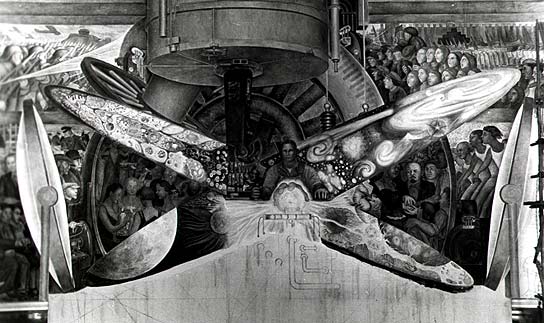
I didn’t realize how closely the Modern’s 1932 Murals and Photomurals exhibition and the anti-communist controversy it provoked dovetailed with the far better known confrontation over Diego Rivera’s rejected and destroyed commission at Rockefeller Center.
Rivera had a hugely successful one-man show at MoMA in 1931. Lincoln Kirstein’s exhibition of murals by American artists was, as he said in the catalogue, “Stimulated in part by Mexican achievement, in part by recent controversy, and current opportunity.” The recent controversy, it turns out, was a January 1932 protest by art students from the New School, who objected to reports that John D. Rockefeller Jr. had selected foreign artists, Rivera and Jose Maria Sert, not Americans, to paint murals in Rockefeller Center. Check out this incredible NYT headline:
WANT NATIVE ART IN ROCKEFELLER CITY; Students Protest on Hearing A Report That Rivera and Sert Are to Paint Murals. ARTISTS NOT YET CHOSEN Architect Promises Citizens Will Have an Equal if Not Better Chance for Commissions. FOREIGNERS CRITICIZED Class at School for Social Research Declares Selection of Any Aliens for Building Here “Inconsistent.”
Which means the Modern’s show, which came together in a matter of weeks, was more an attempt by the Rockefellers to blunt nativist criticism in the wake of a Rivera lovefest as it was a helpful promotion of the work of American artists for anyone who might find himself in the market for a few thousand square feet of murals. [And for the record, ascribing this decision to the Rockefellers and not the Museum per se is fine; the show originated in the Advisory Committee, headed by the 23-yo Nelson Rockefeller.]
But this also means that trustees’ objections to anti-capitalist-themed works, and the ensuing threats of a protest and boycott by a dozens of artists in the show, did not happen out of the blue; they occurred in the context of the Depression, where anti-foreign sentiment was as readily expressed as anti-capitalism. And more to the point, it happened in and around a Museum founded by the family that was the symbol of capitalism, who was in the middle of one of the largest building projects in history.
And sure enough, that fall, Rivera was announced as John D. Rockefeller’s pick for a fresco in the complex’s flagship, the RCA Building. It can’t have been a naive decision. The day after Rivera arrived to begin work on the Rockefeller Center mural, his just-finished mural cycle at the Detroit Institute of the Arts, Detroit Industry, came under attack for “blasphemy.” [The DIA had invited local religious leaders to comment on it, and because one small panel in the upper corner depicted a swaddled baby being vaccinated by three wise scientist men, some clerics demanded the work be destroyed. Go figure.]
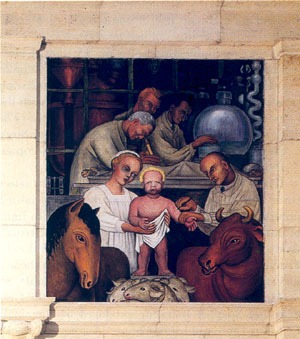
The Times kicked off its play-by-play coverage of the project by “the fiery crusader with a paint brush,” by noting “DIEGO RIVERA is again the centre of a raging controversy. and his new job at the RCA Building in the Rockefeller Center is likely to provoke another.”
And sure enough, less than three weeks later, after it became clear that that was no random baldheaded, goateed man in the center of Man At The Crossroads with Hope and High Vision to the Choosing of a New and Better Future, but Lenin himself, Nelson Rockefeller was called in to persuade Rivera to genericize the figure. Rivera refused, and he was quickly paid off and barred from the premises. Eager to not have the nearly-completed work photographed, the Rockefellers first covered it with drapery, and within a day, had covered it with canvas. After unsuccessful attempts spearheaded by Abby Aldrich Rockefeller, John D’s wife, to salvage the mural, perhaps to put it in the Modern, it was destroyed. Which prompted workers to protest anew in April 1934.
Now I knew it was a controversy, but I had no idea how heated and seat-of-the-pants the whole situation was, nor what a spectacle. It was on the front page of the Times for days, weeks, even. I also didn’t realize how incredible it was that Lucienne Bloch managed to take the only photos of the mural before it was covered up. Bloch began working as Rivera’s assistant after she was seated next to him at the Modern’s 1931 opening dinner.
The whole photo drama was retold [with perhaps a bit of anti-capitalist gloating?] in Bloch’s obituary in 1999:
Lucienne Bloch, an acclaimed muralist whose most significant contribution to art may have been a series of surreptitious photographs she took in 1933, died on March 13 at her home in Gualala, Calif. She was 90.
She was the photographer whose sneak pictures taken behind enemy lines on May, 8, 1933, are the sole visual record of the great Diego Rivera’s ill-fated Rockefeller Center fresco with its doomed depiction of Lenin.
At a time of economic distress, when capitalism itself seemed vulnerable to competing currents of social change, if anybody was going to pin Lenin on a capitalist wall it was Diego Rivera, the fiery Mexican muralist whose artistic acclaim was matched only by his reputation as a fiercely committed, if renegade, Communist.
If anybody was going to stop him it was John D. Rockefeller Jr.’s son, Nelson A. Rockefeller, who had commissioned Rivera to paint a 1,000-square-foot fresco, ”Man at the Crossroads,” in the great hall of the new RCA Building, the soaring Rockefeller Center capstone now known as the G.E. Building and at the time an especially potent symbol of capitalism.
Rivera used Bloch’s photos to recreate the Man at the Crossroads later in Mexico City.
Propaganda For Love [And/Or Europe]
“Civilization is in an acute form of crisis. But the germs of a future culture are floating in the air. It is possible that one day the first flowers may spring up here on American soil.”
– Gordon Onslow Ford, 29, opening his lecture on Surrealism at the New School, January, 1941.
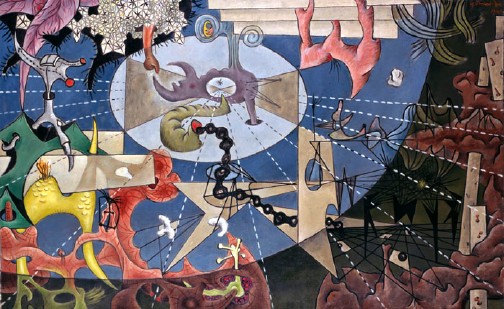
Gorky, Motherwell, Matta, Tanguy and Pollock were apparently in the audience.
Onslow Ford was sent to the US as part of the Committee to Preserve European Culture. Art historian Martica Sawin transcribed the lectures, which are published for the first time in the catalogue accompanying the artist’s first NY show since 1946, at Francis Naumann.
The only online references to this Committee are in relation to this show, and Onslow Ford’s bio. [google cache here, as the page is not currently visible from onslowford.com] He was an officer in the British navy, and given leave for the lectures. His 2003 obit says “an expatriate group” invited him, and he was certainly preceded to NY by many of his older surrealist colleagues.
But instead of returning to the war, “he decided to join other Surrealists in Mexico seeking greater isolation to travel his own artistic path.” He camped out in a hacienda in a remote village for six years, then moved to San Francisco [where he co-founded that crazy hippie art barge, the Vallejo.] Which sounds an awful lot like ducking the war and hiding out in BF Mexico. Just sayin’.
“Gordon Onslow Ford: Paintings and Works on Paper 1939-1951,” curated by Fariba Bogzaran, through Dec. 23 francisnaumann.com via
nyt]
Artists And Their Bohemian Laissez-Faire
I assume everyone has already clicked through and read the excerpt from Martin Duberman’s 2007 Lincoln Kirstein biography where he talks about the controversy that erupted around the Museum of Modern Art’s 1932 murals show, right? The one where a couple of outspoken trustees demanded that Kirstein remove the “offensive” [i.e., anti-capitalist] works or else cancel the whole show?
So you probably already know and love this quote about artists and their politics from the Museum’s director Alfred H. Barr:
Barr, according to Lincoln, told him that if the artists intended to “mix themselves up with an imposed political ideology, they will lose all the values of a Bohemian laissez-faire which up to the present they have desired.”
Indeed, words to live by. Best to leave political, class, economic, and labor issues to the experts uptown.
Ant Farm 20:20 Kohoutek Letterpress
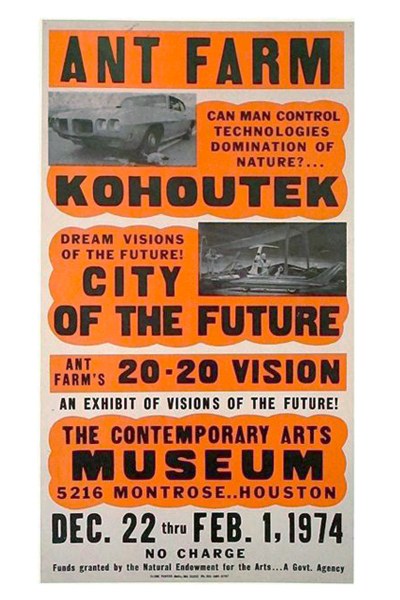
I’ve been deep in the commercial letterpress lately, and neglecting my Ant Farm. Fortunately, Mondo Blogo is there to bring me back in line, with this awesome poster the Farmers made for 20:20 Vision, their show at CAMH.
20:20 featured a Dollhouse of the Future named Kohoutek, after a comet that was supposed to crash into the earth or something, sending hippies into an apocalyptic panic, but it missed, bumming everyone out. In Kohoutek’s Living Room of the Future, naked Barbies lounge around on biomorphic sofas watching a live data feed from SkyLab, seemingly unaware that they’re being raised as food for the comet-surviving ants.
According to a review in Architectural Forum, there were 20:20 t-shirts as well as posters for sale. I’m dispatching my army of Houston vintage pickers forthwith.
And even though Houston was the first place Ant Farm unveiled their plans for the Dolphin Embassy, I think my favorite part is there at the bottom:
“Funds granted by the National Endowment for the Arts… A Govt. Agency”
ant farm: sex, drugs, rock & roll, cars, dolphins & architecture [mondo-blogo, thanks andy]
Previously: Cue the Dolphin Embassy [greg.org]
MoMA’s Murals By American Painters And Photographers, 1932

New York, montage photomural, Berenice Abbott, all images via moma’s 1932 catalogue
I’ve been meaning to post this for a couple of months, but with museum censorship battles and political mural controversies in the news, what better time, right?
When I started researching the history of photomurals–or more precisely, the photomurals of history, since I was mostly just posting various photomurals I’d discovered–I was interested in their context, in the exhibitions and expos they were created for, and whether they were considered or treated as art.
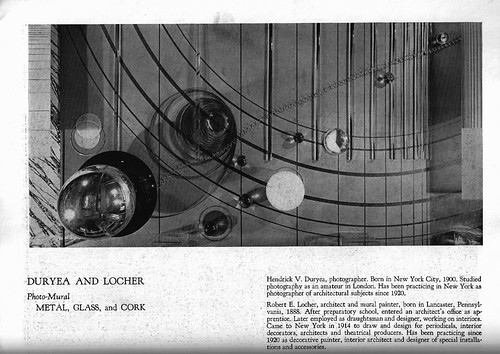
Metal, Glass and Cork, Hendrick Duryea and Robert Locher
Continue reading “MoMA’s Murals By American Painters And Photographers, 1932”
Photo-Murals, By Julien Levy, 1932
You know what, I could try and just quote the awesome parts, or hold up for scrutiny or amusement the seemingly unquestioned assumptions about art, painting photography, and decoration that inform it.
But instead, I have just typed in all of Julien Levy’s catalogue essay on photomurals from the Museum of Modern Art’s 1932 exhibition, “Murals by American Painters and Photographers.” It’s after the jump.
Levy was a pioneering photography dealer who was brought in by Lincoln Kirstein to curate what would be the Modern’s first exhibition of photography. It’s really hard to overstate the importance of Levy’s role in the history of art and photography. He saved, with Berenice Abbott, Atget’s photos. He gave first shows in the US to Brassai, Cartier-Bresson, Moholy-Nagy. [He organized the US premiere of Moholy-Nagy’s short film work, Lichtspiel in 1932 which, really? Because it barely premiered in Berlin in November 1932. That’s hardcore.] He had the first surrealism show in the US. He promoted the found and anonymous photograph as readily as the known artist’s work. And though he barely sold any actual photos in the 17-year life of his gallery, he was a remarkable and prescient advocate for the medium as art.
In 2006, the Philadelphia Museum staged an incredible exhibition of photos and material from Levy’s archive, which they’d acquired from his widow. Check it out for more details and context of Levy’s significance.
Levy opened his gallery in the fall of 1931. The Modern show opened in May of 1932. If nothing else, this essay reflects Levy’s thinking of photography and art, cinema and pai.nting, at an early stage of his involvement with a nascent medium. Enjoy.
The Gala As Art As Slideshow
The Gala As Art, greg.org, at #rank 2010 from greg allen on Vimeo.
Here’s the narrated slideshow I did at #rank during Art Basel Miami Beach.
Many thanks to Jen and Bill for inviting me, to Magda for instigating, to all the SEVEN galleries for hosting, and to Michelle Vaughan for sharing her sharp gala insights. And a huge thanks to Jean, whose advice helped structure a drive-by blog post into a more coherent [I hope] argument. And who insisted I go do the talk, even though it meant celebrating our tenth anniversary early and late.
Thanks, too, to the artists and photo sources, including, in random order as I think of them: Andrew Russeth/16miles.com, Artforum.com, Andrea Fraser, MoCA, LACMA, the Rubell Family Collection, Jennifer Rubell, Kreemart, Christoph Brech, Getty Images, Patrick McMullan, the daily truffle, billionaire boys club, Vernissage TV–don’t these credits make you just want to hit play right this second??
The audio’s rough, the aspect ratio wonked out at the last minute, and I’d do better to just rebuild the whole thing rather than adapt my Keynote slides. And while there’s no gift bag at the end, I did manage to edit out a whopping 12 minutes of um’s, pauses, and “wait, I want to go back to the previous slide”s. I guess media training is NOT like riding a bike.
